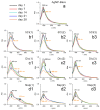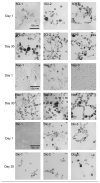Ostwald Ripening and Antibacterial Activity of Silver Nanoparticles Capped by Anti-Inflammatory Ligands
- PMID: 36770389
- PMCID: PMC9920692
- DOI: 10.3390/nano13030428
Ostwald Ripening and Antibacterial Activity of Silver Nanoparticles Capped by Anti-Inflammatory Ligands
Abstract
Silver nanoparticles (AgNPs) have been extensively studied during recent decades as antimicrobial agents. However, their stability and antibacterial activity over time have yet to be sufficiently studied. In this work, AgNPs were coated with different stabilizers (naproxen and diclofenac and 5-chlorosalicylic acid) in different concentrations. The suspensions of nanostructures were characterized by transmission electron microscopy, UV-Vis and FT-IR spectroscopic techniques. The antibacterial activity as a function of time was determined through microbiological studies against Staphylococcus aureus. The AgNPs show differences in stabilities when changing the coating agent and its concentration. This fact could be a consequence of the difference in the nature of the interaction between the stabilizer and the surface of the NPs, which were evaluated by FT-IR spectroscopy. In addition, an increase in the size of the nanoparticles was observed after 30 days, which could be related to an Ostwald maturation phenomenon. This result raises new questions about the role that stabilizers play on the surface of NPs, promoting size change in NPs. It is highly probable that the stabilizer functions as a growth controller of the NPs, thus determining an effect on their biological properties. Finally, the antibacterial activity was evaluated over time against the bacterium Staphylococcus aureus. The results showed that the protective or stabilizing agents can play an important role in the antibacterial capacity, the control of the size of the AgNPs and additionally in the stability over time.
Keywords: antibacterial; nanoparticles; silver.
Conflict of interest statement
The authors declare no conflict of interest.
Figures





References
-
- van Hengel I.A., Riool M., Fratila-Apachitei L.E., Witte-Bouma J., Farrell E., Zadpoor A.A., Zaat S.A., Apachitei I. Selective laser melting porous metallic implants with immobilized silver nanoparticles kill and prevent biofilm formation by methicillin-resistant Staphylococcus aureus. Biomaterials. 2017;140:1–15. doi: 10.1016/j.biomaterials.2017.02.030. - DOI - PubMed
-
- Zhou Z., Bai X., Li P., Wang C., Guo M., Zhang Y., Ding P., Chen S., Wu Y., Wang Q. Ag-Activated Metal-Organic Framework with Peroxidase-like Activity Synergistic Ag+ Release for Safe Bacterial Eradication and Wound Healing. Nanomaterials. 2022;12:4058. doi: 10.3390/nano12224058. - DOI - PMC - PubMed
Grants and funding
LinkOut - more resources
Full Text Sources

